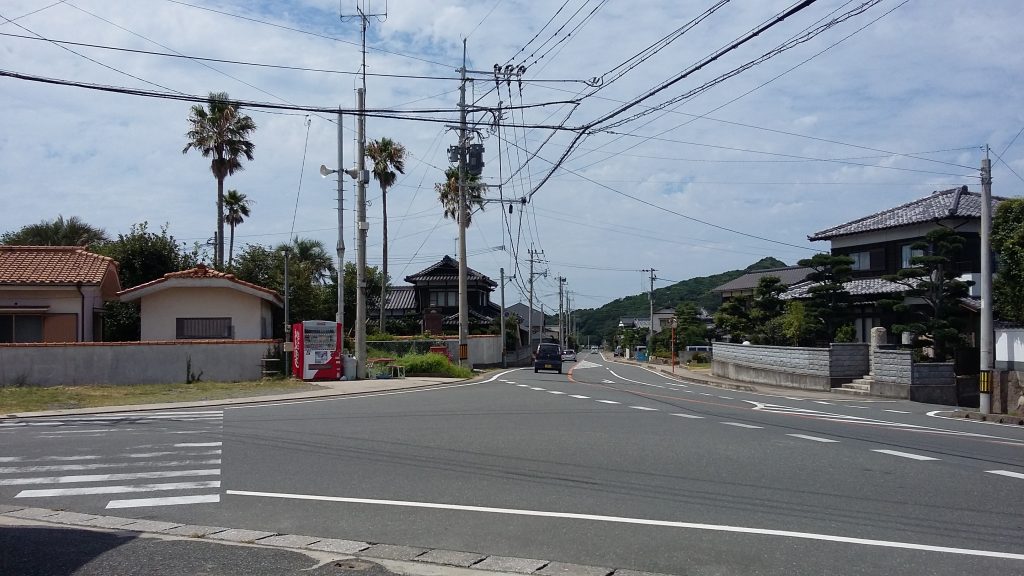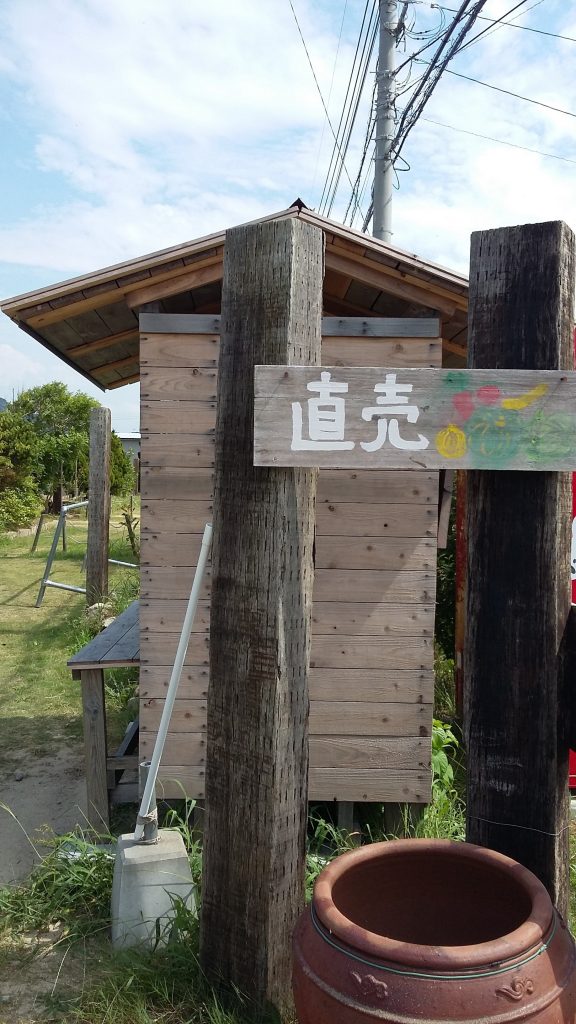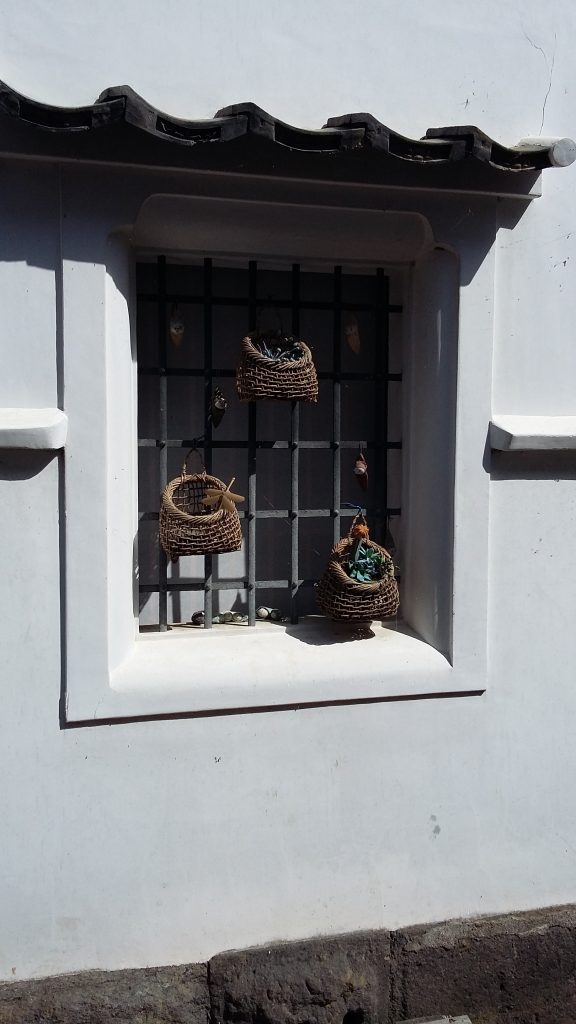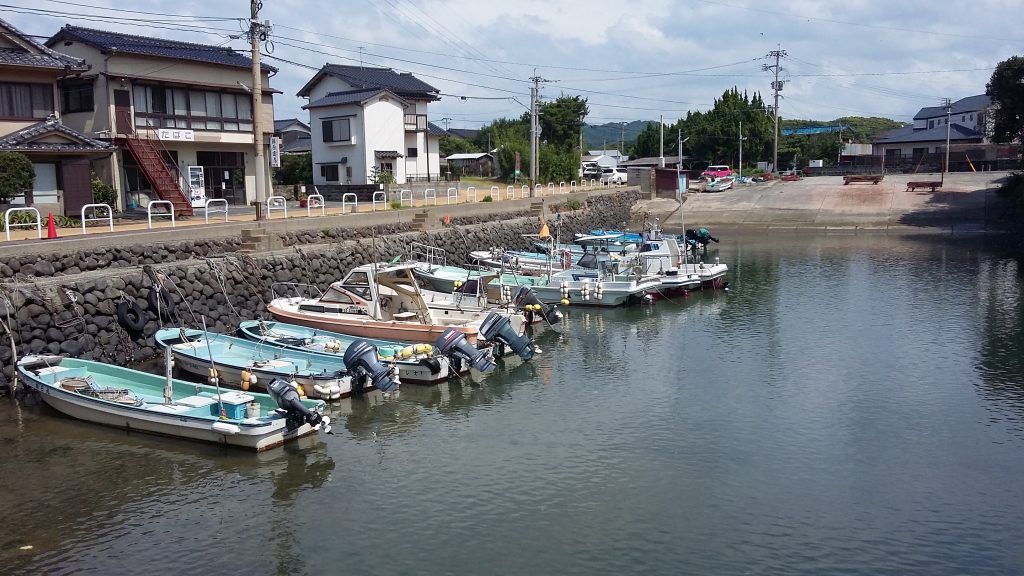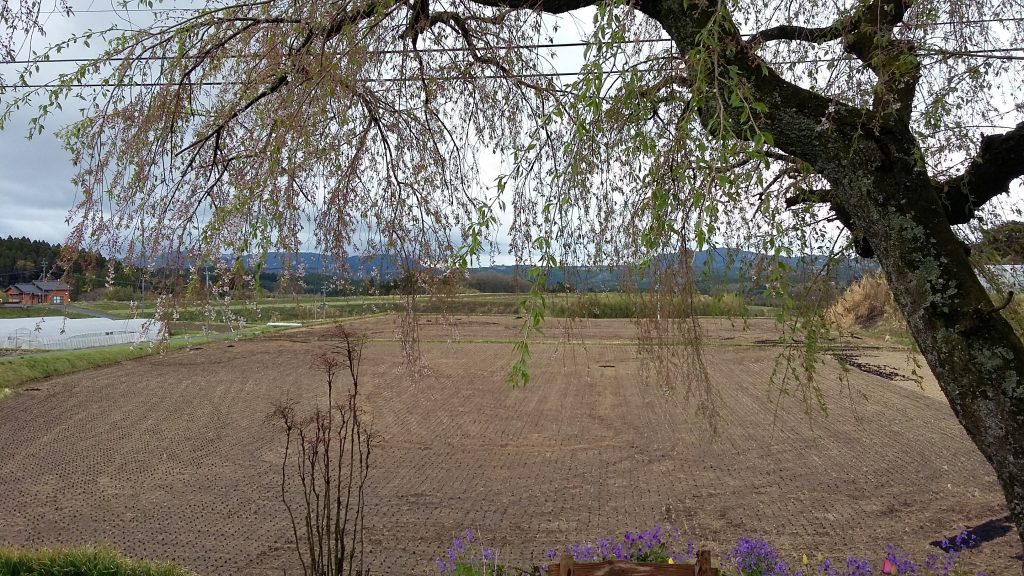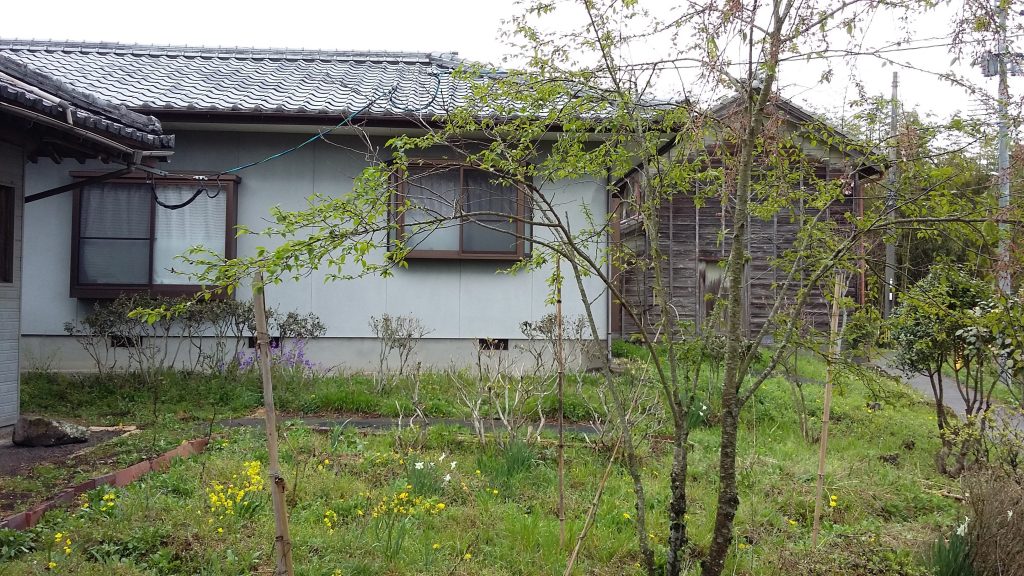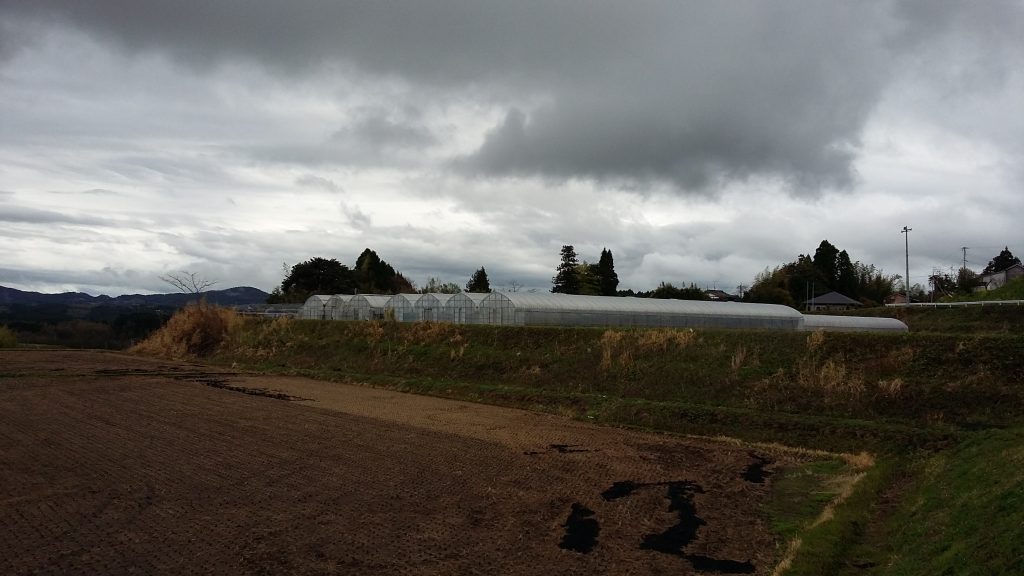Welcome to the blog of the research project “Urban-rural migration and rural revitalization in Japan”. This project is funded by the German Research Foundation (DFG) and started in October 2020. Professor Cornelia Reiher (PI) and her team from the Institute of Japanese Studies at Freie Universität Berlin investigate the impacts of urban-rural migration on rural revitalization in Kyūshū, Japan’s most southern main island. In this blog, our group will give insights into the research process and progress, present first results, share information about our field sites and on related projects and publications. It also features guest contributions by students, PhD students, colleagues and practitioners from Freie Universität Berlin, Japan and universities around the world who work on related projects focusing on urban to rural migration and rural Japan. The editor of this blog is Professor Cornelia Reiher.
Guest Contribution: Invigorating rural communities through convivial craft
by Liliana Morais
Since 2010, I have been researching creative migrants—artists and craftspeople whose mobility is often guided by the pursuit of meaningful work and life. My focus has been on studio potters, practitioners who carry out all stages of production themselves, from preparing clay to firing, thus contrasting with the division of labour typical of traditional craft industries. Their impact on their host communities has led me to explore the potential of such migrants for rural revitalization in Japan and beyond.
During my master’s, I researched the life stories of two Japanese women potters who moved to Brazil in the 1960s and 1970s, motivated both by dissatisfaction with the status quo of ceramics in Japan – where traditional craft fields have been male-dominated – and by a sense of adventure and curiosity about the “New World.” They were part of a larger postwar movement of Japanese artists and craftspeople to Brazil, and a case of what Benson and Riley (2009) call “lifestyle migration”, motivated by the pursuit of quality of life and self-realization, rather than economic or political reasons. Because these women worked with Japanese-style wood-firing – a process using traditional kilns that can last up to several days – they settled in rural areas of Brazil that offered easy access to clay and wood, and fewer concerns about smoke disturbing neighbours. Beyond making pottery, they engaged with Brazil’s long-standing Japanese community, taught ceramics to Brazilian youth, and founded institutions for the dissemination of craft culture (a field historically undervalued as “low-skilled labour” in Brazil). Their activities helped create communities of practice centred around Japanese styles and wood-firing, contributing to attracting tourists, ceramic practitioners, and new residents.

Copyright © Liliana Morais, 2023
A parallel, albeit tiny, movement has developed in Japan since the 1960s, when Western representatives of counterculture and artists began to view non-urban areas and “the East” as sources of cultural knowledge and inspiration. As part of my doctoral thesis, I interviewed Europeans, Americans, and other non-Asians who had come to Japan to study or work with ceramics. Half of them eventually settled in rural areas of the country, often in regions with a long history of pottery. Aside from the influence that the state-promoted image of Japan as a “land of craftsmanship” had on these migrants (which illustrates the importance of traditional craftsmanship to Japan’s soft power to this day), I noticed that some of them were involved in grassroots initiatives aimed at designing a future for their communities. Leveraging local craft history, collaborative production, and transnational networks, these projects have attracted visitors, built relationships, and even encouraged migration to the Japanese countryside.
One such initiative is the Shiro Oni Artist-in-Residence (AIR), founded in 2013 by American artist Kjell Hahn in the former town of Onishi (now part of Fujioka City, in Gunma Prefecture). Hahn first came to Japan through the JET Programme in 2002, later returning to study ceramics and cycle around the country. During this time, he was introduced to Tokyo-born multimedia artist Chiaki Horikoshi, who had built a traditional anagama kiln in a mountain in Saitama, right on the border of OnishiDue to his playful and experimental approach to firing in a primitive Japanese kiln (the history of the anagama kiln dates back to 5th-century Japan, but its recent revival in Japan and beyond has strong ties to the counterculture of the 1960s), Horikoshi’s “kiln parties” became gathering places for artists, students, and people seeking an alternative lifestyle; some eventually moved to Onishi, as Kjell did.

Copyright © Liliana Morais, 2024
After Horikoshi’s death, Hahn took charge of the firings in the anagama, which has now been repurposed for the Shiro Oni AIR. Although the program accepts artists working in any media (priority is given to those who can work with the local community), there are two sessions specifically for firing ceramics in the anagama kiln, and demand has been growing every year. The process, which involves close attention to the rhythms of the fire and feeding it on the clock, takes a total of five days, making it a necessarily collective activity. Artists take shifts on the site, while locals come to help, chopping wood, preparing food, driving the artists up to the kiln site (located in a mountain forest otherwise only accessible by hiking), or simply providing company during the long nights and days.
Several Shiro Oni artists return for a second or even third residency, forming deep and lasting bonds with local residents that often continue well beyond their stay – and in a few cases, even lead them to relocate to the region. Through the Shiro Oni AIR and the Kanna Art Festival (established in 2014), Onishi has come to be known as an “art town”, drawing not only visitors from Tokyo and neighboring cities but also domestic in-migrants who contribute to the revitalization of the community by opening new businesses. Together, they have fostered what Tanaka (2017) describes as a “relationship population” (kankei jinkō): individuals who sustain ongoing ties to a rural place through repeated visits, regular engagement, and continued support.

Copyright © Liliana Morais, 2024
Shiro Oni is one of the case studies in my comparative research on the formation of cosmopolitan craft communities in Portugal, Brazil, and Japan. All cases revolve around Japanese-style wood-firing, a subculture defined by collective effort, experimentation, and a DIY ethos. Although the project is ongoing, the example of Onishi – and others like it – suggests a possible path for rural futures in Japan and beyond: the emergence of fluid, open communities that bring together people from diverse cultural backgrounds around shared acts of craft making that engage with the locality.
While such small-scale initiatives may not be able to halt depopulation (kasoka) or prevent the eventual disappearance (shōmetsu) of some rural settlements, they may transform how decline unfolds. Rather than being defined solely by loss, these projects can nurture new forms of conviviality that render rural degrowth – at least for a time – lively (nigiyaka) rather than desolate.
References:
Benson, M., & O’Reilly, K. (2009). Migration and the search for a better way of life: A critical exploration of lifestyle migration. The Sociological Review 57 (4), 608–625.
Mainichi Shinbun, “American Artist’s Studio Connects Foreigners to Traditional Crafts in Small Town Japan,” Mainichi Japan (July 2, 2021), accessed October 3, 2025, https://mainichi.jp/english/articles/20210701/p2a/00m/0na/023000c.
Morais, L. (2021) From Japan to Brazil: The Ceramics of Shoko Suzuki,” Garland Magazine, August 30, 2021, https://garlandmag.com/article/kogei-between-japan-and-brazil-the-ceramics-of-shoko-suzuki/. garlandmag.com
Morais, L. (2025). Craft as a Tool for Individual and Collective Empowerment: A Japanese Woman Ceramicist in a Rural Brazilian Town. In D. Wood (ed.) The Politics of Global Craft. Bloomsbury (forthcoming).
“Shiro Oni Artist in Residence,” Shiro Oni Studio, accessed October 3, 2025, https://shirooni.com.
Odagiri, T. (2024). Nigiyakana kaso o tsukuru: Nōson saisei no seisaku kōsō [Creating Vibrant Depopulation: Policy Concepts for Rural Regeneration]. Nōsan gyoson bunka kyōkai.
Tanaka T. (2017). Kankei jinkō wo tsukuru: teijū de mo kōryū de mo nai rōkaruinobēshon [Creating a related population: local innovation, not settlement or exchange]. Kirakusha.
Liliana Morais (Ph.D.) is a Specially Appointed Associate Professor in the Faculty of Sociology at Rikkyo University. Her research explores the intersections of craft, transnational migration, and, more recently, rural revitalization, with a focus on Japan from a transnational perspective, based on ethnography and oral history. Before Japan, she was based in Brazil, where curated the exhibition From Japan to Brazil: The Journey of Oriental Ceramics (2012) and published the book Cunha Ceramics: 40 Years of Noborigama Kiln in Brazil (2016, in Portuguese). More recently, she has published articles on the uses of craft for regional revitalization in Japan (“Spicing Up a 150-Year-Old Porcelain Factory: Art, Localism and Transnationalism in Arita’s Happy Lucky Kiln”, 2020), Portugal (“Entangled Ruralities: Remaking a Portuguese Mountain Hamlet Through Craft and Translocalism”, 2025) and Brazil (“Craft as a tool for individual and collective empowerment: a Japanese woman ceramicist in a rural Brazilian town”, forthcoming by Bloomsbury). She is a contributing writer for Garland Magazine and a board member of the Knowledge House for Craft.
Showcasing Rural Japan and Local Crafts at the Osaka Expo
by Cornelia Reiher
In September, I had the opportunity to visit the 2025 Osaka Expo, which took place from April 13 to October 13 under the theme “Designing Future Society for Our Lives.” While world exhibitions mainly showcase nations, Japan’s municipalities and prefectures also presented themselves at the Osaka Expo. I missed the “Local Japan Exhibition” in July, which featured 43 participating prefectures and municipalities from Tohoku to Okinawa, but there was still plenty to discover.

Copyright © Cornelia Reiher 2025
On the day I visited the Expo, it was incredibly crowded and hot. Unfortunately, I didn’t have reservations for the pavilions, so I walked around the wooden Grand Ring and admired each country’s pavilion from the outside. Designed by architect Fujimoto Sou, the Grand Ring was constructed using a mixture of modern building techniques and traditional nuki joints, which are also used in the construction of Japanese shrines and temples. Thus, the Grand Ring itself was a tribute to traditional Japanese woodworking and was quite impressive.

Copyright © Cornelia Reiher 2025
Fortunately, some of the pavilions could be accessed without reservations. Among them were pavilions displaying local crafts, as well as those representing various municipalities and prefectures. First, I visited the “Earth at Night” pavilion, which displayed a giant globe made of Wajima-nuri lacquerware from Ishikawa Prefecture alongside other traditional crafts from the region. The impressive globe has a diameter of 1 m. It is a “’symbol of reconstruction’ that miraculously remained undamaged in the Noto earthquake on January 1, 2024. It is imbued with the hope of ‘conveying to the world the importance of thinking about others beyond conflict and division’.” (Japanese Association for the 2025 World Exhibition 2025).

Copyright © Cornelia Reiher 2025
In the Kansai Pavilion at Osaka Expo, the nine prefectures of Shiga, Kyoto, Hyogo, Nara, Wakayama, Tottori, Tokushima, Fukui, and Mie had separate rooms and exhibited their diverse attractions of history, culture, sights under the theme, “The Brilliance of Kansai’s Rich History and Its Present Day”. The individual exhibits all showcased the scenery of the different prefectures, traditional crafts or local agricultural products. Shiga Prefecture brought its heritage to life through large video displays and virtual tours, featuring Shigaraki pottery, centuries-old weaving, sake brewing, and the famous fireworks over Lake Biwa. Mie highlighted its renowned Matsuzaka cotton, fine ink traditions, and local specialties such as beef, eel, and pickles. Wakayama offered a glimpse into its refined lacquerware, while Tokushima captivated with Otani ceramics and exquisite woven textiles. Together, these exhibits painted a vivid picture of Kansai as a region where history and craftsmanship are deeply interwoven with everyday life.

Copyright © Cornelia Reiher 2025
I also visited one of the buildings in the “Signs of Life” (Dialogue Theater) pavilion (inochi no akashi), which was produced by Kawase Naomi, the famous film director from Nara Prefecture. Two closed wooden school buildings from Nara and Kyoto Prefectures were brought to Osaka and converted into three pavilion buildings. The actual idea of the Dialogue Theater is to bring two strangers together to start a dialogue on various topics on stage. Although I was unable to attend the actual dialogues, one building was dedicated to presenting various places in Nara Prefecture. Traditional handicrafts such as porcelain, wooden sake cups, and kaya, a traditional mosquito net fabric, were on display. I learned that the history of kaya fabric in Nara dates back about 1,700 years and was brought to Japan by craftsmen from China. Kaya weaving continues today, with the fabric being used for everyday items such as multi-layered dish towels.

Copyright © Cornelia Reiher 2025
In the pavilion, representatives from various municipalities in Nara Prefecture distributed flyers and brochures about the sights and history of their respective municipalities. And just like at the Furusato Kaiki Fair I had visited in Tokyo a week earlier, there was information material for potential new residents. In addition to pictures of beautiful lakes and forests, arts and crafts, and local foods, these brochures contained information about financial and other support for potential urban-rural migrants. The pavilion was well attended, and visitors seemed to enjoy the pictures and objects on display and talking to the representatives of the various towns and cities from Nara Prefecture.
Overall, the display of Japanese craftsmanship and local diversity was a great opportunity for municipalities and prefectures in Japan to showcase themselves to visitors from around the world. It was also an occasion for the Japanese audience to learn about the hidden gems of their own country.
Reference:
Japanese Association for the 2025 World Exhibition (2025), “Wajima-nuri Large Globe “Earth at Night” to be Exhibited,” https://www.expo2025.or.jp/en/news/news-20250317-02/
Guest Contribution: Ogijima U-Turn: Keeping the Island Above 100 Residents and Reviving a Closed School
by Meng Qu
In the Seto Inland Sea, Ogijima (literally meaning “Man Tree Island”)—a small peripheral island with a declining population of about 160 (compared to 280 in 2004)—is experiencing a remarkable transformation. While the Setouchi Triennale art festival has raised the island’s visibility and attracted external attention, it did not drive community-led revitalization by itself. The true catalyst has been the Fukui couple, U-turn migrants who relocated from Osaka to Ogijima in 2014 and dedicated a decade to initiatives that strengthened the island from within.

Copyright © Meng Qu 2025
The Setouchi Triennale helped transform Ogijima into one of the region’s “Art Islands,” drawing visitors and attention from across Japan and abroad. Yet attributing the island’s revitalization outcome solely to the festival overlooks the essential role played by the Fukui couple and local residents. Their sustained commitment to community building, education, and sustainable living created the foundation that allowed Ogijima to fully leverage the opportunities brought by the Triennale.

Copyright © Meng Qu 2019
Over the past decade, the island has attracted more than 60 new residents (around 1/3 of its population), many of whom are families with children. This wave of newcomers revitalized the population and ensured the ongoing operation of the island’s elementary and junior high schools. Neighboring Megijima (literally meaning “Woman Tree Island”) offers a stark contrast: despite similar size, population, and transportation connections, its population has declined to fewer than 100, with few families choosing to settle there. This divergence highlights the importance of community agency beyond external attention.

Copyright © Meng Qu 2025
Japan faces a severe challenge of rural depopulation, particularly on remote islands. Many communities have seen hospitals, schools, and other infrastructure close due to declining populations. Ogijima’s school had shut down years ago. Reopening the school was an extraordinary challenge: it required convincing Takamatsu City—a municipality of over 400,000 residents—to allocate roughly 20 staff members, including ten teachers and ten administrative personnel, to keep a school with only six students running on an island of just over 100 residents. Ensuring the school’s long-term viability further depended on attracting families with children, a challenge faced by rural communities nationwide.
Accompanied by the ultimate decision to reopen the school, in 2016, the Fukui couple established the Ogijima Library in a renovated century-old house. The library serves multiple purposes: it is a space for reading, community gatherings, and cultural activities, and it provides after-school programs and learning opportunities for local elementary and junior high students. For visitors drawn by the art festival, it also offers a café and a welcoming space, fostering interactions between tourists and the island community and integrating tourism with everyday local life. In other words, it serves as the community’s hub, acts as a bridge for people from outside who are considering moving to the island, provides a space for residents and children to interact and learn, and also continuously maintains the island’s vacant houses.

Copyright © Meng Qu 2025
The reopening of Ogijima’s school demonstrates the resilience of collaboration between residents and newcomers. The new generation of islanders—centered around the Fukui couple and other migrants—actively seeks families with school-age children from urban areas. Simply attracting entrepreneurs or tourism-focused migrants boosts labor but does not secure the school’s long-term sustainability. The Fukui couple’s vision extends beyond education. They aim to cultivate a sustainable community where culture, nature, and education coexist harmoniously. Their efforts have inspired others to invest in Ogijima’s future, ensuring the island remains vibrant for generations to come.

Copyright © Meng Qu 2025
Ogijima offers valuable lessons for other rural communities. Its experience underscores the importance of grassroots initiatives, the transformative potential of U-turn migration, and the necessity of comprehensive strategies integrating education, culture, and community development alongside lifestyle and entrepreneurial initiatives. Importantly, Ogijima illustrates that rural revitalization cannot succeed without local agency and clearly defined community priorities—such as the rallying cry, “To ensure the island never falls below 100 residents” and “We need our school back!” No amount of external support can awaken a village unwilling to act, unless its own residents collaborate and invest effort. While studies and media often emphasize the role of migrants, this contribution can be overstated. What truly matters are the changemakers—residents who actively drive transformation. These may include I-/U-turn migrants, lifestyle migrants, entrepreneurs, or frequent visitors such as neighbors and student volunteers.

Copyright © Meng Qu 2025
According to Mr. Fukui, he and the residents, together with neighboring island communities, are now considering including Megijima and Ōshima in their revitalization plans. If Megijima—without nearby neighbors—were to disappear, Ogijima would effectively become isolated. The historical and cultural value of the two islands, long referred to as the “Male and Female Islands” (Ogi and Meigi) cannot be preserved. We look forward to seeing the ongoing efforts and contributions of changemakers in revitalizing the archipelago as a whole. After relocating, many of these newcomers and changemakers are often unable to enjoy the so-called “lifestyle” benefits they had hoped for; on the contrary, they often find themselves even busier than they were in Osaka. We have also witnessed their socially beneficial initiatives beyond simply settling and sustaining life on the rural island. At the same time, a new question emerges: lifestyle migrants and entrepreneurs increasingly face stringent expectations regarding rural revitalization. Sustainable revitalization of these communities cannot rely solely on the voluntary dedication of individuals; broader social, cultural, and logistical considerations must also be addressed.
References and additional resources:
Ogijima Library (English link): https://ogijima-library.or.jp/en/english-information/
David Douglas Stuart (2023). David family’s rural island (Ogijima) migration experience in Japan by Australian multimedia journalist and educator – David Douglas Stuart (from ABC news) Island Note Curated Audiovisual Essays https://www.sicri.net/ruralislandmigration
Qu, M., He, Y., McCormick, A. D., & Funck, C. (2024). Diagnosing uneven revitalisation outcomes among aging communities in Japan’s Island art festival. In E. Papoutsaki & S. S. Niaah (Eds.), Island art and music festivals. University of the West Indies Press, 3-26.
Qu, M., & Zollet, S. (2023). Neo-endogenous revitalisation: Enhancing community resilience through art tourism and rural entrepreneurship. Journal of Rural Studies. 97. 105-114. https://doi.org/10.1016/j.jrurstud.2022.11.016
Qu, M., McCormick, A. D., & Funck, C. (2022). Community resourcefulness and partnerships in rural tourism, Journal of Sustainable Tourism 30 (10), 2371-2390. https://doi.org/10.1080/09669582.2020.1849233
Meng Qu, Ph.D., is an Associate Professor and Deputy Director at the Center for Advanced Tourism Studies, Hokkaido University. His research focuses on the revitalization of rural communities through international art festivals, emphasizing socially engaged art, regional festivals, creative tourism, relational aesthetics, creative in-migrants, sustainability, and rural regeneration. He integrates documentary filmmaking as a method for fieldwork and public engagement. Drawing on interdisciplinary approaches from creative and tourism geography and rural studies, he is currently leading a comparative project on community-embedded art and rural revitalization across the Asia-Pacific and the EU.
“We want you!” Impressions from the 2025 Furusato Kaiki Fair in Tokyo
by Cornelia Reiher
I am back in Japan and had the chance to visit the Furusato Kaiki Fair at the Tokyo International Forum. Of the many fairs in Japan’s major cities, such as Tokyo, Osaka, and Fukuoka, where individual regions or prefectures present themselves, this is the largest fair where Japan’s municipalities and prefectures showcase themselves to encourage people to move there. The annual two-day event is organized by JOIN Furusato, an organization that promotes migration from cities to rural areas, as well as regional revitalization. In this post, I will share my impressions of the fair.

Copyright © Cornelia Reiher 2025
When I arrived a few minutes before the start of the fair, people were already lining up to be admitted. There were visitors of all ages and all kinds. Among them were older men who had come alone, young couples, and families with small children. Some had a hippie vibe, while others dressed more like office workers. Admission to the fair was free, but visitors were asked to register online in advance and download an app that could read QR codes. To enter, they had to scan the QR code at the entrance and at each stall they visited to count the number of visitors.

Copyright © Cornelia Reiher 2025
Even before entering the event, I passed several booths where municipalities displayed and sold local foods and handicrafts. Staff members wearing happi with their municipalities’ or prefectures’ names introduced local businesses and their products. I was introduced to sea salt from Chiba Prefecture, its taste and nutritional value depending on the phase of the moon when it is harvested. Other prefectures sold fruits, vegetables, and washi paper. On the same floor, organizations such as JForest and the Ministry of Internal Affairs and Communications introduced their programs, including Chiiki Okoshi Kyoryokutai (COKT) and Furusato Working Holiday.

Copyright © Cornelia Reiher 2025
After entering the main hall, where several hundred municipalities and prefectures presented themselves at individual booths, I tried to make my way to the booths of our field sites in Kyushu. However, the Kyushu booths were at the back of the hall, and I had a hard time getting there because representatives from various municipalities were constantly inviting me to their booths. The enthusiasm of the representatives from the municipalities made me feel like they really wanted me to move there. The advisors also explained that I was welcome as a foreigner. However, I could only receive financial support under certain conditions, they told me. I was also offered to participate in a match making program to find a husband at one prefecture’s stall which had designed this program to attract single migrants. At many booths, I received personalized advice about the advantages of the different places and the support services available to migrants. I also received gifts such as jam, tea, and nori. In addition to brochures and photos, some booths showed videos on tablet computers. At each stall, I was asked to follow the towns or organizations on Instagram.

Copyright © Cornelia Reiher 2025
When I finally arrived at the Kyushu booths, I realized that only one of our four field sites was represented. I met old acquaintances and new people who were representing their communities at the fair for the first time. Some local government officials were accompanied by COKT participants. Some communities offered tea, brochures, and karaage recommendations, while the Saga Prefecture team enthusiastically distributed resources, stories, and even a small prize. Each city presented different incentives, from financial support to guided tours. I was particularly touched by the warmth of the representatives from Ureshino and a sincere conversation with a migrant from Usa, who shared how moving with his family had changed their lives.

Copyright © Cornelia Reiher 2025
Overall, I was happy to experience the fair and see how well-attended it was. Although I was exhausted from visiting what felt like 1,000 stands, and my luggage is now several kilos heavier from all the flyers and brochures I collected, I enjoyed the diversity of locations represented. Local representatives’ genuine enthusiasm for their municipalities and prefectures will certainly encourage people to move to the countryside. However, it is difficult to find the right place among such a large selection. From the many urban-rural migrants I interviewed in Kyushu, I learned that the Furusato Kaiki Fair and similar events are important contact points for people who already feel the desire to relocate to rural Japan. Often, the next step is a visit to the municipalities that made an impression at the fair. Fortunately, these municipalities offer numerous opportunities, such as trial houses and guided tours to prospective migrants, which have already been reported on in other posts on this blog.
Living together or alone? Imagining community in rural sharehouses in Japan
by Cornelia Reiher
Many urban-rural migrants in Japan relocate to the countryside because they are looking for a community and meaningful social relations. They contrast the anonymous urban space with more closely-knit social ties in the countryside. However, rural life often includes unexpected loneliness. Newcomers’ well-being matters to rural municipalities, because local governments try to attract new residents in order to fight depopulation and rural decline. If, however, migrants feel lonely and leave, they cannot contribute to rural revitalization, local governments might receive less subsidies in the future and population decline continues. To create spaces, where newcomers can build community, sharehouses became quite popular among urban migrants in the countryside. They are places where community is negotiated between urban and rural residents.

Copyright © Cornelia Reiher 2023
In my interviews with urban migrants in rural Kyūshū, newcomers remembered their urban lives as mainly commuting back and forth between their work and their small apartments in buildings where they knew no one. Among other reasons, they mentioned a longing for meaningful social relationships as a reason to relocate to the countryside. However, urbanites often move to rural areas based on idealized notions of community, and once they start their new lives, some felt lonely, judged or excluded. This is especially true for single women over the age of thirty. My research participants in this age group reported that they were either criticized for being single or confronted with attempts to set them up with the sons of their neighbors. Urban migrants who had come to rural Japan through the Chiiki Okoshi Kyoryokutai Program (COKT) often felt unaccepted, isolated or monitored. They often feel obliged to justify their funding to the municipality and its residents or stressed by their high visibility in everyday life and the often too close connections with neighbors. And most COKT members are very busy and have little opportunity to socialize outside of work (with each other or with locals) (Reiher 2025).
The Covid-19 pandemic made things worse. Despite the initial low infection numbers in most rural communities, social and community life changed greatly. Although the pandemic has led to a positive reassessment of the countryside and an increase in urban-rural migration, opportunities for urban newcomers to meet people were limited as local festivals and events were cancelled. Voluntary social distancing remained the norm until 2023. (Reiher 2024). Many migrants who moved to rural areas during the pandemic reported that they had little social contact at first and suffered more than others from the migration barrier (ijū no kabe) after the pandemic, as locals had no opportunity to get to know them. In some cases, this led to migrants only socializing with other migrants and parallel societies emerging, while in other cases, migrants who suffered from loneliness, isolation, or exclusion moved away again after a short time. Moving into a sharehouse was a solution for others.

Copyright © Cornelia Reiher 2023
According to Caitlin Meagher (2020), a sharehouse boom in urban Japan began around 2007. However, in rural Japan, sharehouses are still rare. But with the increase of urban-rural migrants, their numbers have risen in the past decade. Especially in rural areas where the ‘traditional Japanese home’ and conservative family values are still strong, living with non-kin is perceived as “unusual” if not strange or even subversive by some local residents. Sharehouse residents I met stressed that they did not enjoy living by themselves and were explicitly looking for sharehouses when relocating to the countryside. Especially during the COVID-19 pandemic when it was difficult to meet other people, they could make new friends in the sharehouse and did not feel lonely. Many moved into sharehouses in the countryside after living alone for a long time and realized that living with others made their life richer. Others were scared when living alone in old detached houses in the countryside and all enjoyed shared meals and sharing food.

Copyright © Cornelia Reiher 2023
However, the idea of unmarried and non-kin people of different sexes living together under one roof, did not meet with approval of all locals in my field sites. Older people in particular had difficulty understanding such a lifestyle. This shows that sharehouses remain primarily an urban phenomenon. At the same time, the aging local community needs newcomers to sustain communal infrastructure and is willing to cooperate and engage with sharehouse residents and their alternative lifestyle. In this sense, sharehouses in rural Japan are places where newcomers and locals negotiate ideas of community, although newcomers’ ideas of shared living differ from the concept of “living-together” in mainstream rural society. The owners and residents of sharehouses imagine community in a new way, overcoming kinship-based notions of family and community. At the same time, they reach out to the locals and invite them to experience their way of living together. In addition, sharehouses in rural areas are places where urban migrants can live in the context of increasingly scarce housing. Sharehouses become transitional spaces for urban migrants, offering short-term stays to test rural life, housing for those facing loneliness and hubs for newcomers and locals to connect. Thus, sharehouses can serve as catalysts for change in rural areas, inspire migration and help alleviate social isolation.
References:
Meagher, Caitlin (2020), Inside a Japanese sharehouse: dreams and realities, London and New York: Routledge.
Reiher, Cornelia (ed.), 2024. Lived experiences of crisis in rural Japan: An anthology on the transformation of communities and migration during the COVID-19 pandemic, Berlin: CrossAsia Open Access Repository. https://doi.org/10.48796/20241202-000
Reiher, Cornelia (2025), “(In)visible newcomers: Foreign workers and internal urban-rural migrants in Japan’s countryside,” Journal of Rural Studies 114, https://doi.org/10.1016/j.jrurstud.2025.103561
Art-based revitalization in rural Japan
by Cornelia Reiher
As rural communities in Japan face socioeconomic and demographic challenges, Japan’s central and local governments have increasingly turned to culture-based strategies for revitalization, including the recruitment of urban creatives. They offer artists atelier spaces, financial support and opportunities to engage with rural life to promote regional economies and especially tourism. The Japanese government has allocated large sums of money to subsidize art festivals, galleries and artist-in-residence programs throughout rural Japan (Tagore 2024).

Copyright © Cornelia Reiher 2022
In 2004, the UNESCO Creative Cities Network (UCCN) was created to promote cooperation with and among cities that have identified creativity as a strategic factor for sustainable urban development (UNESCO 2025). In response to this UNESCO initiative, Japan’s Cultural Agency created the bunka geijutsu sōzō toshi suishin jigyō (Arts and Culture Creative City Promotion Project) and since 2010 provides subsidies to local governments to “support […] initiatives in which local authorities, civic groups […] and local private companies work together to solve regional problems by harnessing the creativity of culture and the arts in a range of areas such as regional development, tourism and industrial development […]” (Bunkachō 2010). In 2013, the Creative City Network of Japan (CCNJ) was established as a platform to promote cooperation and exchange among creative cities in Japan and in the world. Municipalities could apply for grants and become members of this network.

Copyright © Cornelia Reiher 2022
A-Town, a small town in the mountains of Kyushu (population 19,686), made art a pillar of its revitalization strategy and applied for funding from the Cultural Agency and for registration as a member of the Creative City Network of Japan. To retain and attract new talent to his town, the mayor at the time, promoted the town as Creative City and founded an artist-in-residence program and a co-working space to make the city a magnet for urban creatives. For the artist-in-residence program, a vacant school building was renovated with the subsidies from the Cultural Agency and converted into studio space that artists could use free of charge. Due to these measures, A-Town became very attractive for artisans and artists during the past decade.

Copyright © Cornelia Reiher 2022
A-Town’s art-based revitalization strategy goes hand in hand with the preservation of architectural heritage and the promotion of urban-rural migration. In order to provide artists and craftspeople with work and living spaces, the mayor offered them abandoned buildings designated as cultural assets, which were renovated with the help of government grants. Thus, revitalization through art and culture also became a means of reusing vacant buildings (akiya) (Platz 2024). To give artists the opportunity to earn a living, the local government strategically used the Chiiki Okoshi Kyōryokutai program (COKT) to pay invited artists a salary for three years (Reiher 2025).

Copyright © Cornelia Reiher 2022
One of the artists who relocated to A-Town is Shigeru. He was employed by COKT as part of A-Town’s artist-in-residence program. Currently, he divides his time between A-Town and Tokyo. Since finishing the program, he has been living and working in a house he found with the help of the former mayor. Shigeru feels a strong connection to the area and loves the nature which increases his well-being, but feels excluded from the local community. He uses local materials, studies the history of A-Town, and draws inspiration from it. Shigeru is involved in the local community in various ways. However, he feels that artists from outside of A-Town are not welcome in the community, because the locals do not understand their way of life. For this reason, Shigeru mostly spends time with other artists who have moved to A-Town. Although he acknowledges the contribution of newcomer artists to the town, particularly that their studios, workshops, and exhibitions attract other artists and tourists, he also points to a divide between the newcomers and the locals. Therefore, he is rather pessimistic about the local government’s Creative City project and his own impact on the revitalization of A-Town.

Copyright © Cornelia Reiher 2022
In the past decades, art projects and artist-in-residence programs were given greater consideration by local and central governments in their fight against depopulation and aging in rural Japan. The support programs prepared the ground for the subsequent influx of newcomers to these rural areas, attracting younger and more diverse people. Nevertheless, the relationship with the local community is crucial to the success of these initiatives, but residents are not necessarily open to newcomer artists. Local governments and other stakeholders initiating arts-based revitalization should enhance their efforts to explain these initiatives and to involve residents in decision-making processes, art projects and the benefits of the arts. Without community support, art-based revitalization projects may not be very sustainable, benefit only a few stakeholders, and even cause inconvenience to locals due to large numbers of tourists.
References:
Bunkachō (2010), Bunka geijutsu sōzō toshi suishin jigyō https://www.bunka.go.jp/seisaku/bunka_gyosei/chiho/creative_city/suishinjigyo/
Platz, Annemone (2024), “From social issue to art site and beyond – reassessing rural akiya kominka”, Contemporary Japan 36, 1, pp. 41-56.
Reiher, Cornelia (2025), “(In)visible newcomers: Foreign workers and internal urban-rural migrants in Japan’s countryside,” Journal of Rural Studies 114, https://doi.org/10.1016/j.jrurstud.2025.103561
Tagore, Eimi (2024), Art festivals in Japan: Fueling revitalization, tourism, and self-censorship, Contemporary Japan 36, 1, pp. 7-19
UNESCO (2025), Creative Cities Network, https://www.unesco.org/en/creative-cities
Contemporary bamboo art from rural Japan
by Cornelia Reiher
On the way to Taketa, the train winds through thickets of bamboo on either side of the tracks. As it passes through valleys, bamboo forests, mountains, and tunnels, branches whip against the train’s windows. It becomes clear even on the journey why this small town in the mountains of Kyushu, Japan’s southernmost main island, bears the name “Bamboo Field.” Bamboo is omnipresent in Taketa, whether in nature, as a building material, or at the annual bamboo lantern festival. Bamboo is traditionally a material and motif used in arts and crafts throughout Japan, but Oita Prefecture, where Taketa is located, is particularly well known for its high-quality bamboo work.

Copyright © Cornelia Reiher 2023
Hajime Nakatomi, a bamboo artist born in Osaka in 1974, has lived in Taketa since 2012. I visited his studio in a former school to meet him. In the early 2000s, Taketa’s city administration began inviting artists and craftspeople specifically to revitalize the old castle town, whose population was ageing and shrinking. To create studio space, the vacant school, which now houses Nakatomi’s studio, was renovated. The mayor at the time offered Nakatomi a studio and a place to live in the hope that his fame would attract other artists and craftsmen. The plan worked, as the artist is renowned in the small yet international bamboo community for the contemporary aesthetic of his creations, which he exhibits worldwide.

Copyright © Cornelia Reiher 2023
Nakatomi’s studio, located in the school’s former music room, is quiet, with only the regular sound of a grinding machine to be heard. Nothing suggests that objects are being created here for the international art market. Two assistants split bamboo and cut strips of various lengths. Much of this work is carried out on the floor. In an adjoining room are bamboo trunks several meters long. Tools are lined up on a shelf, and individual parts for projects are carefully packed and numbered. Some of the more delicate sculptures that Nakatomi sells all over the world are displayed on tables. While many craftsmen make everyday objects from bamboo, Hajime Nakatomi bends and weaves dyed bamboo into abstract shapes. Interwoven rings form coral-like shapes, while others resemble strands of DNA. It seems as if there is nothing Nakatomi cannot do with bamboo. He finds inspiration in nature and everyday life. For example, the “Frill” series, which traces the wind blowing through clothing, was created to celebrate the birth of his daughter.

Copyright © Cornelia Reiher 2023
Hajime Nakatomi’s fascination with nature and bamboo is evident as he presents his work and demonstrates the steps involved in the crafting process. Bamboo craftsmanship exemplifies the interconnection between humans and nature. Of the more than 500 species of bamboo in Japan, only about ten are suitable for his work, Nakatomi explained. He has trunks delivered from northern Kyushu but also manages a bamboo grove in Taketa, where he cuts the trees, he selects for his projects. He relies on patience to find suitable trees. The bamboo must be three to four years old. If it is older, the rings between the individual sections become too hard. The trees should grow on an eastern slope so they aren’t burned by the sun. After felling the bamboo, the trunks must be left to dry for two weeks and then washed so the oil can escape from the wood. Then, the bark is removed, changing the bamboo’s color from green to light brown. A sweet scent is created during this process, filling Nakatomi’s studio.

Copyright © Cornelia Reiher 2023
Hajime Nakatomi demonstrates how to rethink traditional Japanese handicrafts to preserve them, giving bamboo works a contemporary aesthetic. He learned traditional craft techniques at the Ōita Prefecture Bamboo Craft Training Center and as an assistant to bamboo master Shoryu Honda. Accordingly, Nakatomi devotes considerable time to each step of the process. Each step is always carried out in the same sequence to achieve perfection. He wants to create pieces that aren’t immediately recognizable as bamboo to surprise his audience. Only upon closer inspection should viewers penetrate the work more deeply and be enchanted. Thus, bamboo becomes a medium of silent magic that transcends cultural boundaries and explains Hajime Nakatomi’s international success.
Guest contribution: Rural connection through digital nomads
by Axel Eriksson
“I’m not in Kansas anymore,” goes the expression from The Wizard of Oz, uttered when Dorothy finds herself beyond what once seemed normal. In the back seat of a car winding through the roads of south-eastern Honshu, I thought the same as we headed out to collect bamboo shoots at a cabin with two of my informants. Next to me sat a Japanese digital nomad, almost leaning over the front seat to chat in Japanese with the driver, who had her seat belt on, while her three-year-old child, unbuckled, sat beside her. Any romantic image of a safe Japan from TikTok faltered during this experience. Driving in Japan is intense, not exactly aggressive, but certainly energetic, though still conducted with a tone of respect. As they chatted, I struggled to follow the conversation with my limited Japanese, so I switched on my newly downloaded AI translator app for a test run: “That’s what capitalism does, isn’t it?” the driver said, to which the digital nomad hummed in agreement. The future of Japan seems to be on everyone’s lips here in the countryside.
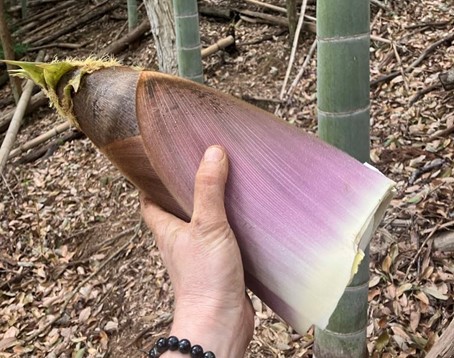
Copyright © Axel Eriksson 2025
The reason I was sitting in this car is my search for foreign digital nomads across rural Japan. Not long ago, Japan—like many other countries—caught the fever to attract those who use remote work to travel for extended periods. Yet freelance workers, business owners and others have long been able to detach themselves from a fixed home in favour of a more mobile lifestyle. What this new life could be was already described as early as 1997, when Tsugio Makimoto and David Manners coined the term in their book Digital Nomad, which, in the late-1990s spirit of Fukuyama’s book The End of History, envisioned a bright economic future shaped by mobility—a hopeful era in which those on the “right side of history” could escape the constraints of capitalist life. Now, nearly 25–30 years later, while the digital nomad visa may be the most widely known policy tool, many other schemes have emerged to support small-scale entrepreneurs in making digital nomadism viable—particularly in rural Japan. Digital nomads carry an aura of new hope, especially in connecting rural Japan to the wider world.
Trying to find any digital nomads in the Japanese countryside, however, felt almost like researching dead ends. Anyone who has done fieldwork knows that the world rarely unfolds as planned—each encounter turns out to be disturbingly different in ways that seem contradictory or nonsensical at the time. The timing seemed ideal: the yen is weak and many people now enjoy endless flexibility to travel while working remotely. Before starting my fieldwork, I had believed that digital nomads would be wandering freely across Japan. Yet when I arrived in the countryside, they were only a few. “Have you gone to Fukuoka?” countless people asked me rhetorically, as if already knowing the answer. “You’ll find what you’re looking for there.” Indeed, Tokyo, Osaka and Fukuoka are teeming with digital nomads—just like any other type of tourist. Outside these areas, they are far harder to come by. Even Sapporo in the north, where I had hoped to begin my journey into rural Japan, felt empty outside the season I had just missed. Cities accommodating tourists seem to swallow digital nomads into the same gravitational pull. Their mobility often mirrors that of tourists, arriving with the seasons—Hokkaido in winter, Tokyo in spring for the cherry blossoms.

Copyright © Axel Eriksson 2025
Digital nomads do occasionally venture beyond the classic tourist cities—not by chance, but thanks to the intensive efforts of co-working spaces. My search led me to rural cities and towns across Japan which, at first glance, seemed no different from small places in Sweden, Portugal or Belgium, where I have lived before, but after some days walking in them it become apparent to me that they are slowly closing down. My realization of the need for revitalization did not come until I arrived in south-eastern Honshu, where I truly grasped the scale of Japan’s depopulation crisis. What began as “Ah, they’ll open later,” soon turned into the quiet realization—peering through shuttered blinds—that “Oh, they’re never going to open again.” In response, digital nomads have become a key tool for connection. A project leader for one such initiative admitted just how few people were coming: “We have to do something. Otherwise, in sixty years, there’ll be no one left on this island.” Digital nomadism is a trend that, if nurtured, could offer rural areas a way to reconnect. It is not the digital nomads that I follow, but connections between these places that provides merits for research.
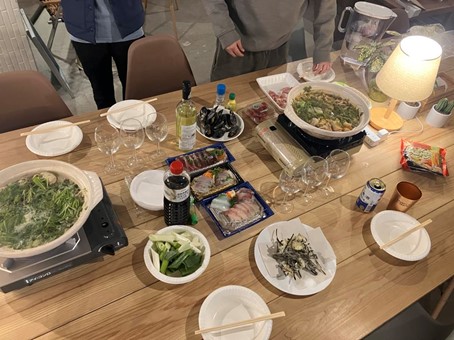
Copyright © Axel Eriksson 2025
As I visit these rural places that trying to attract digital nomads, it is hard to miss the willingness to meet new people and forge connections between temporary visitors such as digital nomads and local residents. On the winding roads of south-eastern Honshu, I find myself beginning to understand what digital nomads might mean for these areas. To most people I met in the countryside, I appear to be one myself. And not unlike other digital nomads, I have packed my belongings into a few cardboard boxes and left to begin another life. In that sense, I have become part of rural revitalization—linked to everywhere else through the presence of nomads. As I look out across the rice paddies in an otherwise densely forested valley, I know I need to return, to connect again with rural Japan. And I must ask myself: what can I, as a ‘digital nomad researcher’, do to help sustain life in these places?
Axel Eriksson is a postdoctoral researcher from Sweden who recently graduated at Mid Sweden University. He was rewarded a JSPS short–term postdoctoral scholarship to be in Hokkaido University in Sapporo conducting ethnographic research across Japan to understand how digital nomads connects to rural Japan. His research focuses on how groups meet and renegotiate their livelihoods, especially through tourism and new foreigner residents.
Report on our research project about urban-rural migration and rural revitalization in Japan
by Cornelia Reiher
Funding for our project ended in October 2024. Please find below a summary of the project report submitted to the German Research Foundation (DFG) and a link to the report itself. I would like to thank everyone who was involved and supported our project.
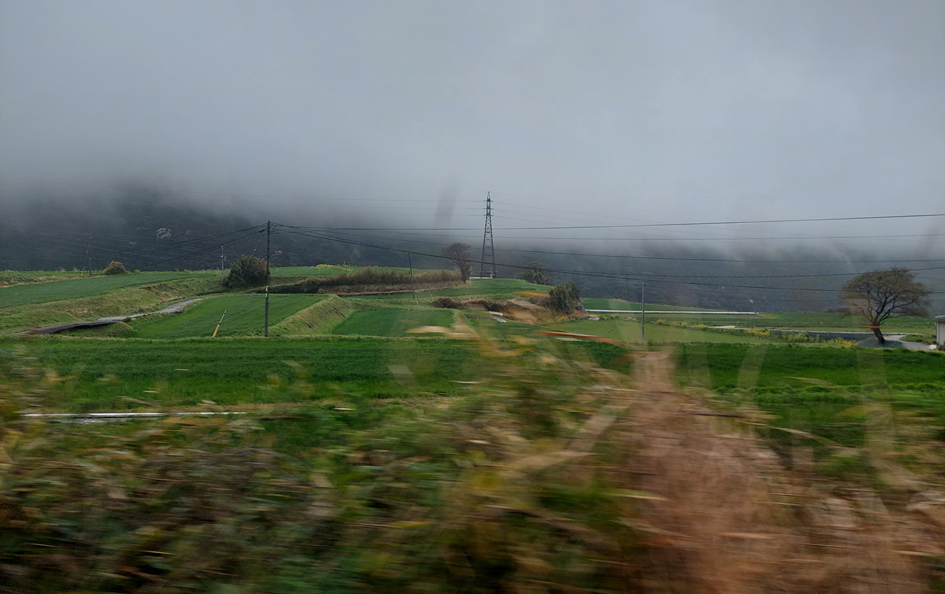
Copyright © Cornelia Reiher 2023
Summary of DFG-funded research project “Urban-rural migration and rural revitalization in Japan”
To counter population decline and labor shortages in rural Japan, central and local governments have launched programs aimed at revitalizing rural areas by attracting new residents to live and work in the countryside. Although the COVID-19 pandemic has changed the perception of rural life and led to an increase in urban-rural migration, the total number of migrants remains small and is unevenly distributed across Japan. Peripheral areas receive fewer newcomers than regions close to cities. This research project compared urban-rural migration in four municipalities in Kyūshū, Japan’s southernmost main island, to find out how urban-rural migration affects rural revitalization. Although all municipalities offer a wide range of quite similar financial incentives and other support programs aimed at encouraging migration, in none of them were numbers of in-migrants high enough to reverse the overall demographic decline. By combining ethnographic research with policy analysis, the research team found that the way central and local governments conceptualize urban-rural migration influences migrants’ self-perceptions and determines their eligibility for support. These classifications are often based on simplistic criteria, such as a migrant’s place of origin, and overlook the complexity of individual migration experiences. We challenge these traditional categories that classify migrants simply according to their place of origin or view migration as settlement by suggesting a more nuanced understanding of urban-rural migration that includes a broader concept of migration embracing more flexible and temporary mobilities. This perspective acknowledges the fluidity of contemporary migration patterns as in each of the four communities, both short-term and long-term urban-rural migrants have made significant contributions. They have started their own businesses, enhancing the appeal of their new hometowns for both locals and tourists, while also generating employment. Beyond their economic impact, these migrants are influencing local culture by introducing new and often mobile lifestyles and new notions of community. Although these changes may be small in quantitative terms, they are notable in terms of the qualitative transformation they bring to rural areas.
Guest contribution: Well-being amongst multiple responsibilities: Researching mothers in the Aso region
by Johanna Mayr
When I was thinking about the topic of my Master’s thesis, I had a dream that my research could have a positive impact on the world. I wanted to learn more about the reality of people’s lives and make these findings accessible to a wider audience so that they could read and become aware of them. As a woman, I have thought about motherhood before and wondered what impact it would have on my life. However, from pregnancy to child rearing, from part-time work to parental leave, and from marriage to relationships, many aspects of family life were only ever a topic I heard about without thinking about. So, the desire arose to help close this knowledge gap, not just for me, but for others pondering similar issues.
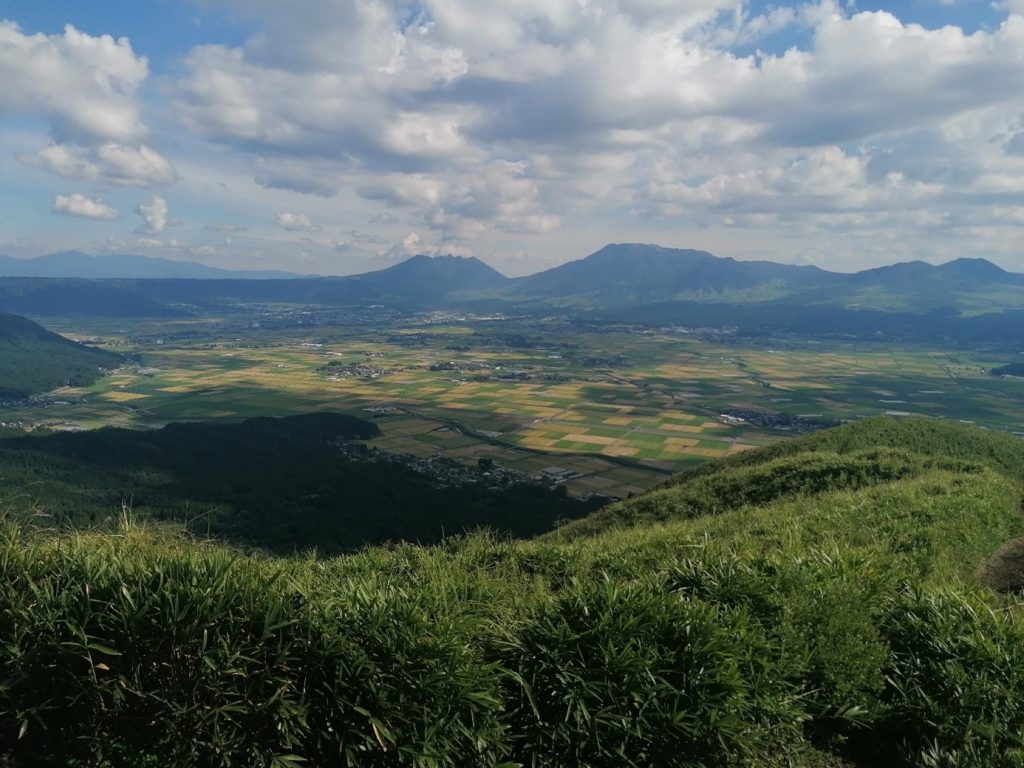
Copyright © Johanna Mayr 2023
From mid-August to mid-September 2023, I traveled to the Aso region in Kumamoto. The Aso region is a rural area consisting of a few municipalities clustered around a caldera with an active volcano in the center. It is famous for its wide and flowing grasslands and is popular with cyclists and golfers, but also with researchers like me. I am not the first person from the Department of Japanese Studies at the University of Vienna to make this region the focus of my work. I was therefore fortunate to have a support network of colleagues, researchers and other contacts in and around the region that I could rely on and turn to. After twenty-one interviews with mothers in Aso, I felt that my knowledge gap had significantly filled with new insights and realizations. We talked about the many responsibilities and roles that women carry and fulfill in their daily lives, from their work (both paid and unpaid, both inside and outside the home) to their friendships and hobbies. Although I cannot provide full results at this stage, as my analysis is still ongoing, I would like to mention some interesting points that have already come to my attention:
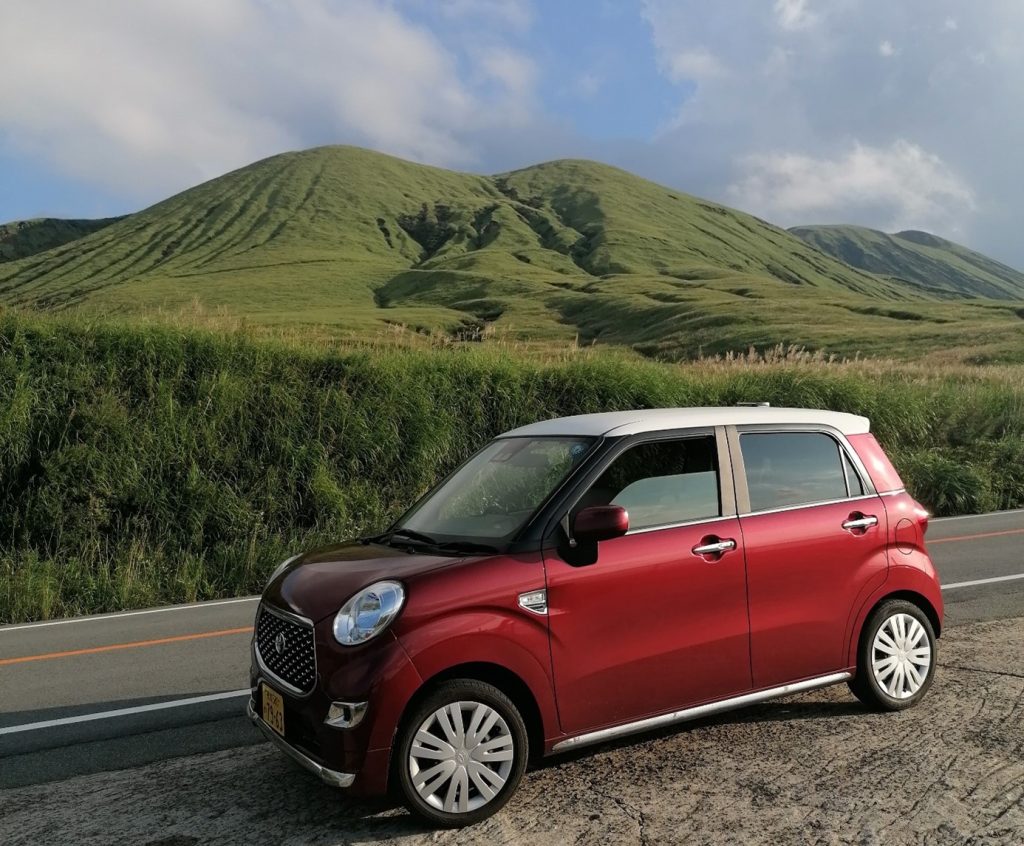
Copyright © Johanna Mayr 2023
Ms. Fujita (all names have been changed to protect interviewee anonymity), for example, talked a lot about the future and not just her present, which focused on her children, her husband, and her work as a restaurant owner. She wants to create as many memories as possible with her family before her children are grown and off to school or work and before her parents and mother-in-law need her help. The responsibility of raising her children can be hard, but planning small outings with them is also a source of joy and hope. She combines this hope with the ability to cope with future challenges and tough times.
This balance between the joy of having a family and the demanding responsibilities that limit one’s time and choices is described in one way or another by almost all the mothers I spoke to. Mrs. Chiba described it very aptly in the context of her work as a kindergarten teacher: “If I didn’t have a job, I wouldn’t be happy, and if I didn’t have a family, and just this job, I think it would probably have been hard. Yes. I feel like inside of me my work is my ikigai [one’s purpose in life or reason to live], and my family is my shiawase [happiness].” However, she also feels controlled by her work, childcare and her household duties. So much so that in her daily life she feels like she does not have the leeway to think much about more abstract concepts like hope, time, freedom and the future. At the same time, she sees herself as someone living freely, since she chose this life for herself.
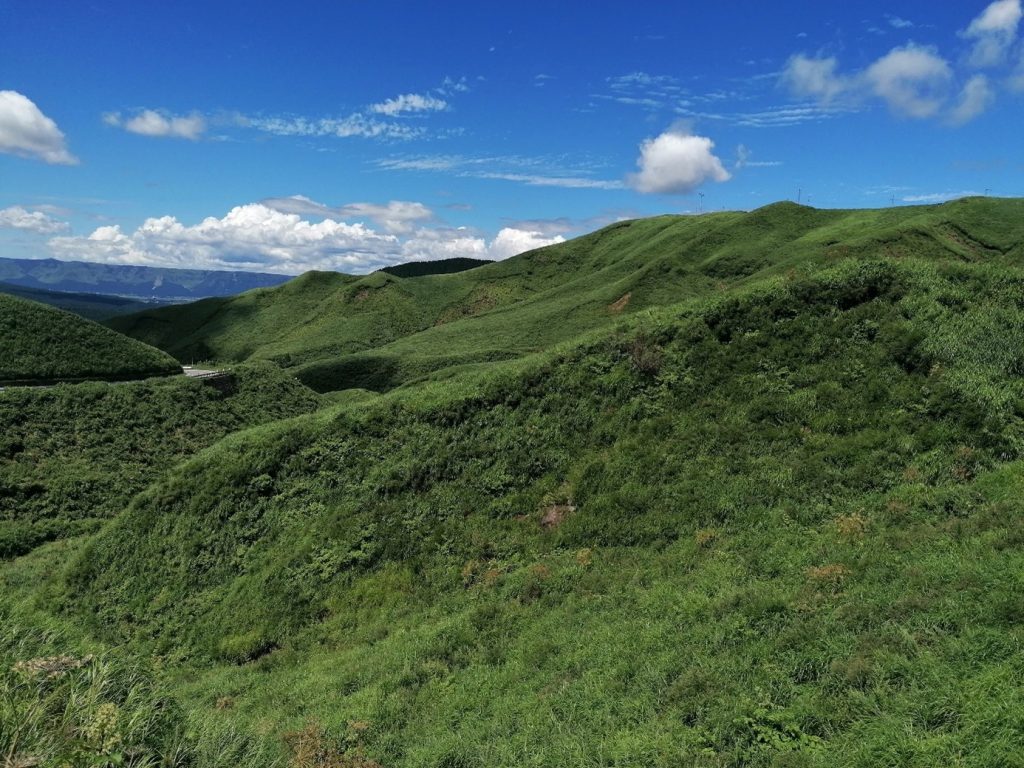
Copyright © Johanna Mayr 2023
Another point that was frequently raised was the fact that you have to make compromises in certain areas of your life in order to prioritize others, especially your family and particularly your children. Ms. Fujita has put her hobbies on hold for the time being until she regains more time and freedom as her children become more independent. Ms. Daichi describes that she has actively decided against club activities as a teacher, although this was her actual goal, for which she became a teacher while her children were still small. She also compromises for the sake of her husband, as he is able to teach club activities, partly because Mrs. Daichi prioritizes childcare duties.
These stories of mothers from Aso show that our lives are multi-faceted. Perhaps we are all simply balancing our joys and hardships, trying to outweigh the negatives with the positives and shifting our priorities as our environment and situation allows. Whatever the case, I believe that learning about other people’s experiences is invaluable and that it is important to share these insights. One thing I know for sure is that my research has helped at least one person, myself. And I hope it might be helpful or at least interesting to others, perhaps even to someone reading this blog post.
And if there is one piece of advice I could give to future field research beginners: It’s always okay to ask! I did my best to ask whenever, wherever and whoever. Of course, I was turned down a few times, but in the vast majority of cases I was kindly supported, informed and helped. I couldn’t be more grateful!
Johanna F. Mayr is currently studying for an MA in Japanese Studies and an MA in German as a Second and Foreign Language at the University of Vienna. Her research focuses on topics related to gender, identity and well-being.

